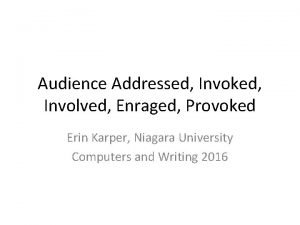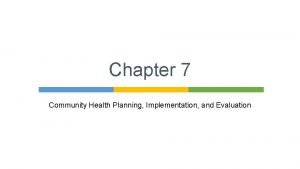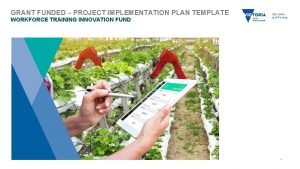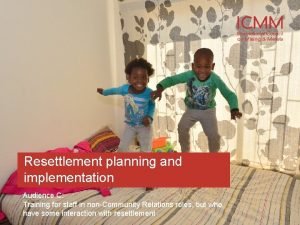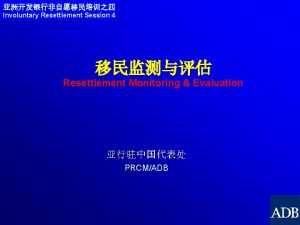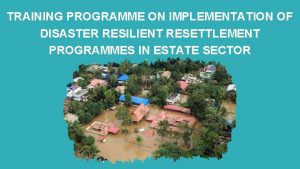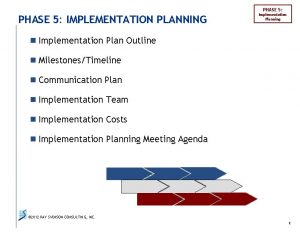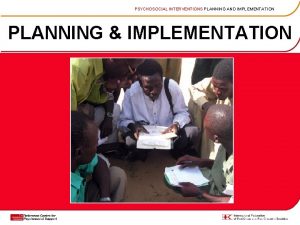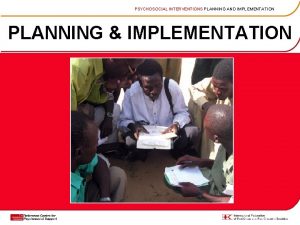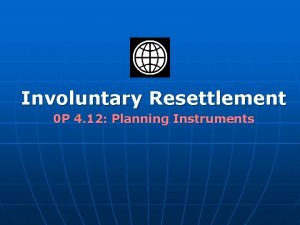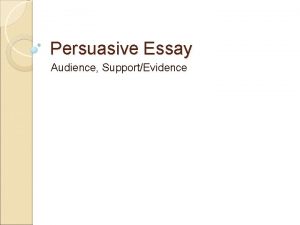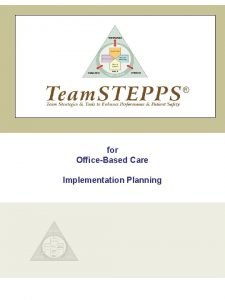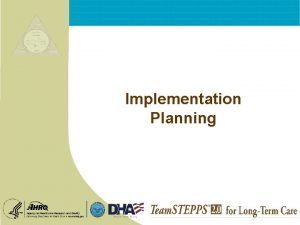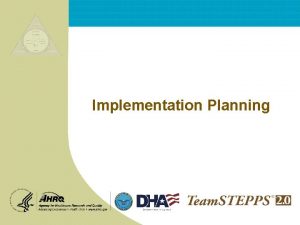Resettlement planning and implementation Audience C Training for















































- Slides: 47

Resettlement planning and implementation Audience C: Training for staff in non-Community Relations roles, but who have some interaction with resettlement

Aims and objectives of this session In this session we’ll explore: What is resettlement and how is it relevant to you? What are the key resettlement standards? What are the key resettlement impacts and risks? What do we need to do in practice? Further information. 2 www. icmm. com Follow us

What is resettlement and how is it relevant to you?

Resettlement isn’t just about moving people (1 of 2) 4 Resettlement is about… This requires… Involvement of following departments… Trying to avoid or minimize resettlement Consideration of project design options Engineering and project design team Finding suitable resettlement sites Inputs from a variety of departments to ensure suitability of proposed sites Hydrology; environmental; community relations; geology; legal; finance; human resources; procurement, etc. Seeking consensus Engaging with authorities, from national to local level GM and HODs, depending on the issue at hand www. icmm. com Follow us

Resettlement isn’t just about moving people (2 of 2) 5 Resettlement is about… This requires… Involvement of following departments… A very resource intensive process (time and budget) On-going review and consideration of resources required Finance; procurement; human resources A high risk process for businesses Identification and management of company-wide risks The whole company… A process which is inevitably marked by tension and conflict On-going efforts to maintain companycommunity relations All personnel who engage with stakeholders and will feel the relational strain of the resettlement process www. icmm. com Follow us

Exercise: A few questions to consider 1. In what way might resettlement pose a risk to the company? 2. In what way would a resettlement process impact on your current work responsibilities? 3. How would you expect the company to behave with regards to the resettlement of local households? 6 www. icmm. com Follow us

Defining resettlement and associated standards

Defining resettlement Resettlement: the disruption and displacement of communities resulting from project-related land acquisition and restrictions on land use Voluntary or involuntary Voluntary: when resettled households have the choice to move Involuntary: when affected persons or communities do not have the right to refuse Physical or economic Physical: relocation or loss of shelter Economic: loss of assets or access to assets that leads to loss of income sources or other means of livelihood 8 www. icmm. com Follow us

Standards and legislation governing resettlement International standards IFC Performance Standard 5: Land Acquisition and Involuntary Resettlement considered the international gold standard National legislation Resettlement legislation tends not to cover full set of resettlement issues. Beyond compliance thus essential, although risks to business exist in closing the gap. Industry organisations ICMM SD Framework: members to respect human rights (Principle 3) and contribute to the social, economic and institutional development (Principle 3 & 9) Company’s corporate policy on resettlement 9 www. icmm. com Follow us

National legislation Slide for you to insert a summary of national resettlement legislation that is relevant to the countries where you operate. 12 www. icmm. com Follow us

Our resettlement policy Slide for you to insert a summary of your company’s resettlement policy. 13 www. icmm. com Follow us

Objectives of resettlement planning (1 of 2) 1. Avoid or at least minimize involuntary resettlement wherever feasible 2. Avoid forced eviction 3. Mitigate adverse social and economic impacts from land acquisition or restrictions on affected persons’ use of land by: a) Providing compensation for loss of assets at replacement cost; and b) Appropriate disclosure of information, consultation, and the informed participation of those affected. 14 www. icmm. com Follow us

Objectives of resettlement planning (2 of 2) 4. Improve or at least restore the livelihoods and standards of living of displaced persons 5. Improve living conditions among displaced persons through provision of adequate housing with security of tenure at resettlement sites. 15 www. icmm. com Follow us

Key risks and impacts

Exercise: Imagining yourself resettled 17 www. icmm. com Follow us

Impacts on resettled communities These negative impacts are often particularly harsh for poor and vulnerable groups, while host communities are also affected: • Conflict and the break-up of communities and social support networks • Loss of identity or sense of place • Impeded or lost access to resources • Loss of access to public infrastructure or services, and common property • Compromised livelihoods • Social ills, family breakdown • Decreased marketability of skills in host communities • Cultural impacts • Emotional and psychological impacts. 18 www. icmm. com Follow us

Risks to business Resettlement is a highly complex endeavour, as it concerns both tangible and nontangible impacts. This poses significant risks to business: • Potential conflict, and associated project delays and works stoppages • Restrictions on future developments and loss of future concessions • Financial costs associated with remedying poor practice, litigation, triggering conflict and protracted negotiations • Damaged social licence to operate • Reputational damage • Unsustainable precedent setting • Strain on government-company relations due to differing standards on resettlement. 20 www. icmm. com Follow us

Case study: Risks to business Suggestion: Insert a case study which creates a picture of the risks to business posed by the resettlement process. 22 www. icmm. com Follow us

Resettlement planning What do we need to do in practice?

Resettlement during the project life cycle (1 of 3) Consideration of resettlement should commence as early as possible, with most key tasks being undertaken during the concept, pre-feasibility and feasibility. 1. Exploration 2. Concept • Identify resource • Preliminary assessment of impacted and affected persons • Establish business case • Updated assessment of impacted and affected persons Anglo American’s SEAT 3 Toolbox, Figure 4 D. 1: Resettlement Planning During the Project Cycle 24 www. icmm. com Follow us

Resettlement during the project life cycle (2 of 3) 3. Prefeasibility 4. Feasibility 5. Resettlement 25 • Conduct options analysis to avoid/minimise resettlement • Develop draft RAP • Finalise mine plans and final project approval • Finalise, disclose and seek approval for RAP • Implement and conclude resettlement www. icmm. com Follow us

Resettlement during the project life cycle (3 of 3) 6. Construction • Continue to monitor and evaluate resettlement and implement any necessary remedial measures • Continue monitoring and evaluate resettlement programme • Implement any necessary remedial measures 7. • Conduct completion audit when livelihoods have been restored Operation 8. Closure 26 www. icmm. com Follow us

Essential elements of a Resettlement Action Plan (1 of 2) 1. Efforts to avoid and minimise resettlement 2. Project impacts and affected populations 3. Legal and regulatory framework 4. Compensation framework 5. Details of replacement housing and the resettlement site 6. Plans for livelihood restoration and resettlement assistance 27 www. icmm. com Follow us

Essential elements of a Resettlement Action Plan (2 of 2) 7. Budget for the implementation of the RAP 8. Schedule for the implementation of the RAP 9. Roles and responsibilities 10. Participation, consultation and engagement plan 11. Grievance procedure 12. Monitoring and evaluation (including completion audit). 28 www. icmm. com Follow us

The planning process: Key recommendations (1 of 2) 1. Team planning and project co-ordination • Land acquisition and resettlement planning to start early, and be integrated with overall project planning from the outset • Integrated team of experts to ensure coordinated assessment and planning activities • Accurate RAP budget is essential for weighing up project design alternatives. 2. Minimising resettlement impacts • Include social experts in defining the project footprint, and examining project alternatives • Develop land management plan to ensure on-going input into land requirements • Prepare a RAP or livelihood restoration plan. 29 www. icmm. com Follow us

The planning process: Key recommendations (2 of 2) 3. Planning for life-of-mine land requirements • Finding adequate replacement land is often a major challenge • Start early, and consider life-of-mine requirements, to avoid repeated resettlements due to later project expansion. 4. Community involvement • Resettlement planning cannot be done like other aspects of project planning – communities need to be involved • This includes involvement of the host community, and management of impacts on receiving environment. 30 www. icmm. com Follow us

Key tasks during resettlement planning 1. Stakeholder engagement 10. Monitoring 31 2. Identifying project impacts and project affected people 3. Baseline studies (including host community) 4. Census of all affected households and confirmation of eligibility 5. Inventory of assets and compensation 9. Grievance procedure 8. Implementation of the resettlement 7. Developing livelihood restoration strategies 6. Site selection www. icmm. com Follow us

1. Stakeholder engagement: A cornerstone of resettlement Consult in order to: Stakeholders to engage: • Empower through information sharing • • Include in decision-making All those affected, with a particular focus on vulnerable groups • Identification of resettlement impacts • Displaced communities, regardless of their legal status • Input into compensation and impact management • Host communities • Inform appropriate decision making • Local government, community leaders, traditional leaders. • Build trust amongst all stakeholders. An on-going process throughout the planning process and life of a project 32 www. icmm. com Follow us

2. Identifying project impacts and affected people Identifying a project’s full range of impacts, and the people and communities that will be affected, is key to resettlement planning and associated impact management. Key steps include: Engage with relocated and host communities to understand full range of impacts Conducting socio-economic surveys of all affected people Conducting a census to identify affected parties Conducting inventory of assets Identify compensation parameters and procedures. 33 www. icmm. com Follow us

2. Who are project-affected people (PAPs)? Any person who, as a result of the project, loses the right to own, use, or otherwise benefit from: • Assets • Built structure • Land • Annual or perennial crops or trees, and • Any other fixed or moveable asset, in full or in part, permanently or temporarily, irrespective of whether physical relocation required. 34 www. icmm. com Follow us

3. Baseline studies “The ultimate goal of a RAP is to enable those displaced by a project to improve their standard of living – a goal that requires an examination of social, environmental and economic conditions beyond simple physical inventories. ” The IFC Handbook on Preparing a Resettlement Action Plan 35 www. icmm. com Follow us

4. Census of all affected households A 100% census of all affected households serves to: Register the number of affected parties by residence or locality Establish a list of legitimate beneficiaries before the project’s onset Lays a framework for subsequent socio-economic research Provides a baseline for monitoring and evaluation. 36 www. icmm. com Follow us

4. Confirming eligibility for compensation Those eligible include: • Those who hold legal land rights • Those who do not have formal legal rights to the land they are occupying or using. 37 www. icmm. com Follow us

5. Inventory of assets and compensation: Key asset categories Land Infrastructure Houses and associated structures Cultural, sacred & historical assets. Other private physical assets Business & commercial assets Common property resources Public structures 38 www. icmm. com Follow us

5. Compensation requirements (per IFC PS 5) ü Compensation at full replacement cost, for physical and economic assets ü Transparent and consistent application ü Land for land compensation, wherever feasible ü Compensation before relocation ü Opportunities for development benefits to be provided ü Transitional support to be provided. 40 www. icmm. com Follow us

5. In parallel to compensation: Benefit sharing and community development Use portion of project revenue streams Cultural programmes Livelihoods programmes Benefit-sharing examples Improve community infrastructure 41 Community part-owns project Part of project taxes and royalties to communities Sharing of project services www. icmm. com Follow us

6. Site selection (per IFC PS 5) Key requirements Choice of resettlement options Of equal or higher value Characteristics that are equivalent or better Same location advantages Also consider re-existing communities’ preferences. 42 www. icmm. com Follow us

7. Restoring sustainable livelihoods Restoration of existing livelihoods “like for like” Resettlement & Compensation for losses Physical move Rehabilitation of livelihoods Alternate livelihoods Extremely challenging aspects of resettlement 43 www. icmm. com Follow us

8. Implementation of the resettlement There are inevitably challenges with implementing a RAP. The most common include: • Schedule: In general resettlement projects are typically 10 -24 months behind schedule • Budget: In general, final costs for resettlement can be 300 to 400% higher than anticipated. These need to be anticipated and effectively managed by a comprehensive implementation plan, synchronised with the overall project implementation schedule. Roles and responsibilities also need to be clearly spelt out in the RAP. 44 Construction and the moving process offers important opportunities for achieving positive impacts among communities. www. icmm. com Follow us

9. Grievance procedure Grievances among the affected population are an inevitable component of involuntary resettlement, regardless of its scale. A grievance procedure is therefore essential. It is best to ensure that a grievance procedure is in place to allow affected people (both resettled and host communities) to lodge complaints or claims without cost, and with the assurance of a timely and fair response. Diagram: Example of a complaints procedure, Anglo American 46 www. icmm. com Follow us

10. Monitoring Since the RAP will inevitably fall short of what is required in reality, there is a crucial need to conduct extensive monitoring throughout. A successful monitoring programme requires: Adequate (pre-resettlement) baseline data against which to monitor resettlement progress and impact on livelihoods Clear monitoring indicators to assess performance against baseline conditions Appropriate databases, reporting and collation systems should be put in place to capture and analyse monitoring data An independent monitoring mechanism, which includes community involvement in monitoring and evaluation. 47 www. icmm. com Follow us

When is responsibility for the resettlement over? The company’s responsibility to resettled communities shifts once: • It can be shown that living conditions have been improved • Livelihoods have at least been restored in a sustainable manner. An independent third party to carry out a completion audit to confirm if the above has been achieved. In reality, on-going assistance is likely, in particular for the most vulnerable. 48 www. icmm. com Follow us

The value-add of effective resettlement planning In conclusion

What is the value-add of effective resettlement planning? ü Improved risk management process, throughout the resettlement process ü Minimized resettlement impacts on project-affected people ü The development of a Resettlement Action Plan (RAP) ü Opportunity for improved collaboration with government and civil society ü Opportunity to be change agents and create a positive legacy ü Alignment with international standards and commitments on resettlement. 50 www. icmm. com Follow us

Additional resources Where can I find more information?

Key references 52 www. icmm. com Follow us

International Council on Mining and Metals (ICMM) 35/38 Portman Square London W 1 H 6 LR United Kingdom Switchboard: +44 (0) 20 7467 5070 Main Fax: +44 (0) 20 7467 5071 E-mail: info@icmm. com www. icmm. com
 إسحاق ستيرن
إسحاق ستيرن Race and resettlement act schindler's list
Race and resettlement act schindler's list Invoked audience
Invoked audience Assessment planning implementation and evaluation
Assessment planning implementation and evaluation Azure deployment planning services
Azure deployment planning services Implementasi proyek adalah
Implementasi proyek adalah Training implementation plan template
Training implementation plan template Formuö
Formuö Novell typiska drag
Novell typiska drag Nationell inriktning för artificiell intelligens
Nationell inriktning för artificiell intelligens Ekologiskt fotavtryck
Ekologiskt fotavtryck Varför kallas perioden 1918-1939 för mellankrigstiden?
Varför kallas perioden 1918-1939 för mellankrigstiden? En lathund för arbete med kontinuitetshantering
En lathund för arbete med kontinuitetshantering Underlag för särskild löneskatt på pensionskostnader
Underlag för särskild löneskatt på pensionskostnader Personlig tidbok
Personlig tidbok Sura för anatom
Sura för anatom Densitet vatten
Densitet vatten Datorkunskap för nybörjare
Datorkunskap för nybörjare Stig kerman
Stig kerman Mall debattartikel
Mall debattartikel Delegerande ledarstil
Delegerande ledarstil Nyckelkompetenser för livslångt lärande
Nyckelkompetenser för livslångt lärande Påbyggnader för flakfordon
Påbyggnader för flakfordon Kraft per area
Kraft per area Svenskt ramverk för digital samverkan
Svenskt ramverk för digital samverkan Jag har nigit för nymånens skära text
Jag har nigit för nymånens skära text Presentera för publik crossboss
Presentera för publik crossboss Argument för teckenspråk som minoritetsspråk
Argument för teckenspråk som minoritetsspråk Plats för toran ark
Plats för toran ark Klassificeringsstruktur för kommunala verksamheter
Klassificeringsstruktur för kommunala verksamheter Mjälthilus
Mjälthilus Bästa kameran för astrofoto
Bästa kameran för astrofoto Centrum för kunskap och säkerhet
Centrum för kunskap och säkerhet Verifikationsplan
Verifikationsplan Mat för unga idrottare
Mat för unga idrottare Verktyg för automatisering av utbetalningar
Verktyg för automatisering av utbetalningar Rutin för avvikelsehantering
Rutin för avvikelsehantering Smärtskolan kunskap för livet
Smärtskolan kunskap för livet Ministerstyre för och nackdelar
Ministerstyre för och nackdelar Tack för att ni har lyssnat
Tack för att ni har lyssnat Vad är referatmarkeringar
Vad är referatmarkeringar Redogör för vad psykologi är
Redogör för vad psykologi är Stål för stötfångarsystem
Stål för stötfångarsystem Tack för att ni har lyssnat
Tack för att ni har lyssnat Borra hål för knoppar
Borra hål för knoppar Vilken grundregel finns det för tronföljden i sverige?
Vilken grundregel finns det för tronföljden i sverige? Stickprovsvarians
Stickprovsvarians Tack för att ni har lyssnat
Tack för att ni har lyssnat


